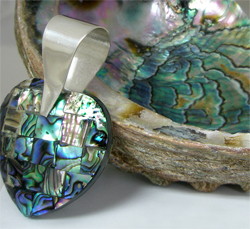 |
|
Abalone Abalones are members of a large class of mollusk’s having one-piece, flattened shells. From species to species, the iridescent nacre that lines the inside of the shell varies in color from silvery white, to pink, red and green-red, through to Haliotis iris, which shows predominantly deep blues, greens and purples. The exceptionally strong shell of abalone has traditionally been used as a decorative item in jewelry, buttons, and as inlay in furniture and in musical instruments such as guitars. Abalone is found worldwide, mainly in the cold waters off the coasts of New Zealand, South Africa, Australia, Japan and North America. It is also known for producing pearls. These are very rare and depending on color can be quite valuable. Unlike pearls from oysters, they don't have to be round. They also don't have the treatments applied to them like pearls such as bleaching and polishing. These are mainly found in New Zealand and Australia. In New Zealand abalone is call paua shell, from the native Maori language. It has a long cultural history in New Zealand. You see many artifacts in the museums from the Maori's made of abalone. Almost all of the abalone shell is harvested by hand by scuba divers, free agent divers, and by picking at low tide by hand. Each country has its own laws and limits - you can actually be jailed in some countries for poaching. Abalone has become protected just like coral and other species of sea life. In the late 1950’s abalone began to be commercially farmed in many countries for the meat. The meat of this mollusk is considered a delicacy in certain parts of Latin America, New Zealand, South East Asia, and East Asia. Wild abalones appear in many different varieties, but the availability of commercially farmed abalone has allowed more common consumption of this once rare delicacy. Here is a youtube.com link to a bed of Abalone off the coast of New Zealand. Pretty cool. http://www.youtube.com/watch?v=cx877AR1Jzg |
Desert Rosing Trading. All Rights Reserved.

